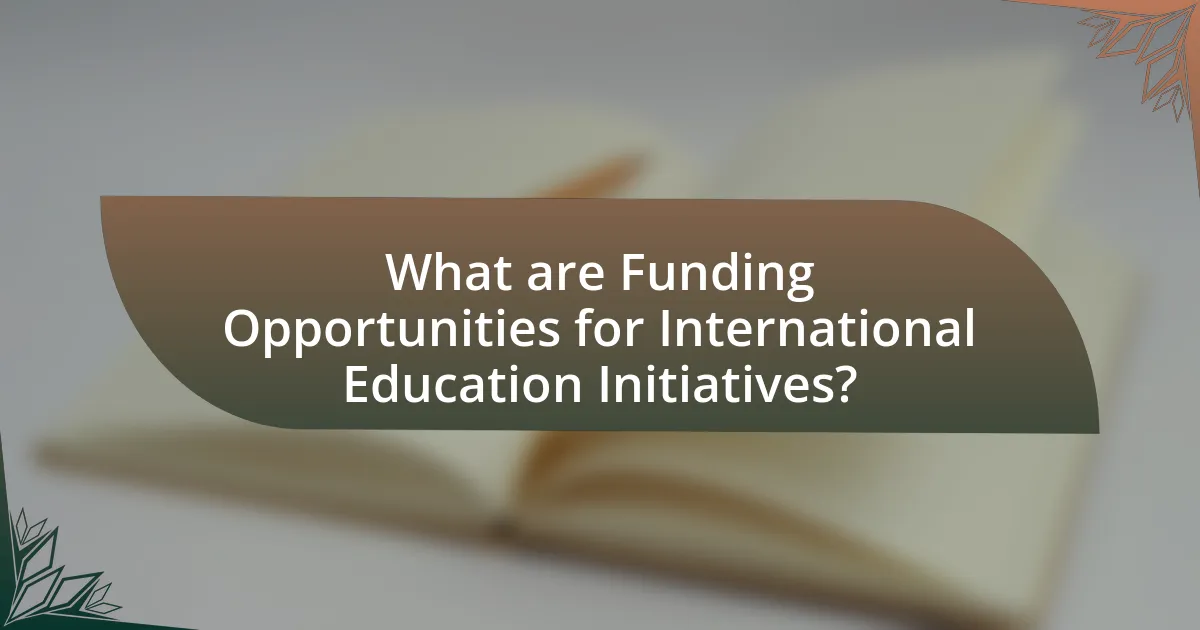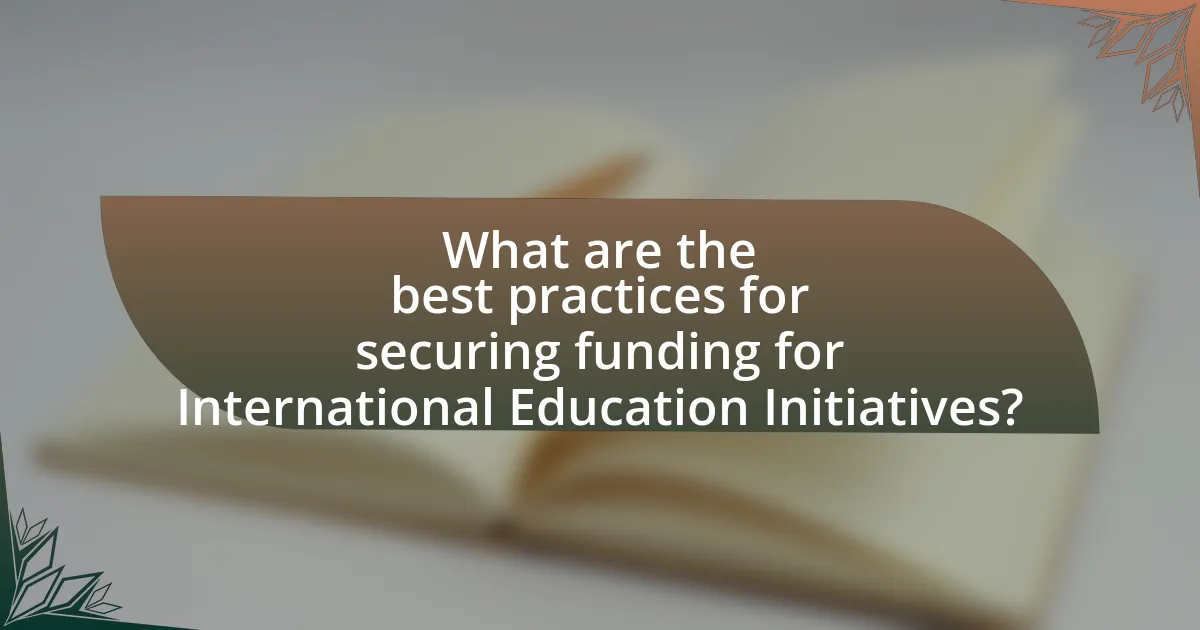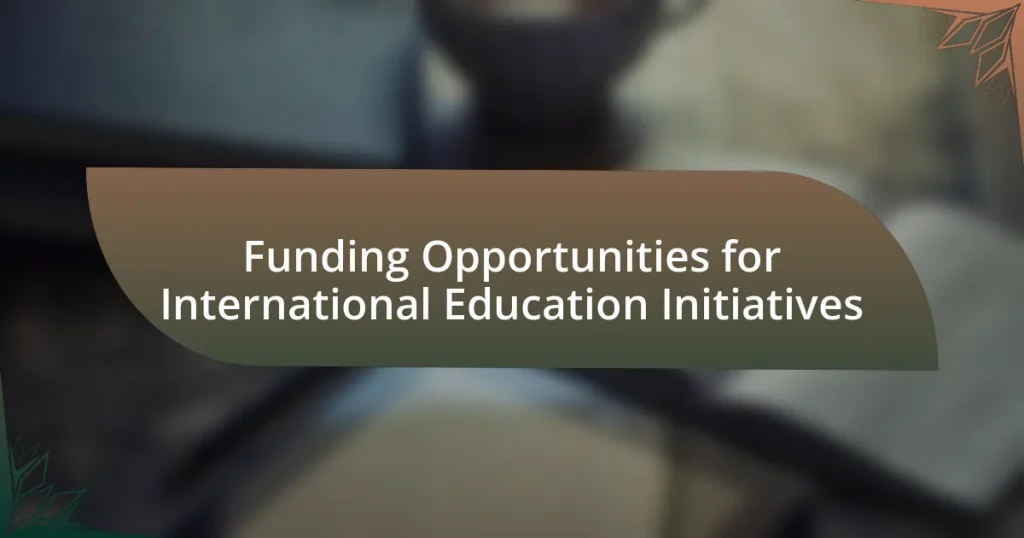Funding opportunities for international education initiatives encompass various sources, including government grants, private foundations, and international organizations. Key programs such as the Fulbright Program and support from UNESCO play vital roles in enhancing global education through financial resources that facilitate curriculum development, teacher training, and student exchanges. The article outlines the significance of these funding sources, the types of projects they support, and the stakeholders involved, while also addressing the challenges faced by initiatives lacking adequate funding. Additionally, it highlights best practices for securing funding, including effective proposal presentation and the importance of networking in the funding process.

What are Funding Opportunities for International Education Initiatives?
Funding opportunities for international education initiatives include government grants, private foundations, and international organizations. For example, the U.S. Department of Education offers the Fulbright Program, which provides funding for educational exchanges and research projects. Additionally, organizations like the United Nations Educational, Scientific and Cultural Organization (UNESCO) support initiatives through various funding programs aimed at enhancing global education. These funding sources are crucial for promoting cross-cultural understanding and improving educational access worldwide.
How do these funding opportunities support global education?
Funding opportunities support global education by providing essential financial resources that enable institutions and organizations to develop and implement educational programs across diverse regions. These funds facilitate access to quality education, enhance infrastructure, and promote cross-cultural exchanges, which are vital for fostering international collaboration. For instance, the Global Partnership for Education has allocated over $5 billion since its inception to improve educational outcomes in developing countries, demonstrating the significant impact of targeted funding on global education initiatives.
What types of projects are typically funded?
Projects typically funded in the realm of international education initiatives include curriculum development, teacher training programs, student exchange programs, and research collaborations. These projects aim to enhance educational quality, promote cultural exchange, and foster global partnerships. For instance, the U.S. Department of Education’s Title VI program supports projects that strengthen foreign language and area studies, demonstrating a commitment to funding initiatives that improve international education.
Who are the primary stakeholders involved in these initiatives?
The primary stakeholders involved in funding opportunities for international education initiatives include government agencies, educational institutions, non-governmental organizations (NGOs), and private sector companies. Government agencies often provide grants and policy support, while educational institutions seek funding for programs and partnerships. NGOs play a crucial role in implementing initiatives and advocating for educational access, and private sector companies may offer sponsorships or funding in exchange for branding opportunities or corporate social responsibility goals. These stakeholders collectively contribute to the development and sustainability of international education initiatives.
Why is funding crucial for international education initiatives?
Funding is crucial for international education initiatives because it enables the development, implementation, and sustainability of programs that enhance global learning opportunities. Without adequate financial resources, initiatives may struggle to provide necessary infrastructure, educational materials, and qualified personnel, which are essential for effective learning environments. For instance, a report by the Global Partnership for Education indicates that countries with increased funding for education see significant improvements in enrollment rates and educational outcomes, demonstrating the direct impact of financial support on educational success.
What challenges do these initiatives face without adequate funding?
Without adequate funding, international education initiatives face significant challenges such as limited program reach, reduced quality of education, and inability to sustain operations. These initiatives often rely on financial resources to develop curricula, hire qualified educators, and provide necessary materials. For instance, a study by the Global Partnership for Education indicates that insufficient funding can lead to a 50% reduction in student enrollment in educational programs. Additionally, lack of funding restricts the ability to implement innovative teaching methods and technologies, which are crucial for enhancing learning experiences. Consequently, these challenges hinder the overall effectiveness and impact of international education initiatives.
How does funding impact the quality of education provided?
Funding directly influences the quality of education by determining the resources available for schools, teachers, and students. Increased funding allows for better facilities, updated technology, and more comprehensive educational programs, which enhance the learning environment. For instance, a study by the National Bureau of Economic Research found that increased per-pupil spending significantly improves student outcomes, including higher test scores and graduation rates. Additionally, funding enables schools to hire qualified teachers and provide professional development, which further elevates educational quality.

What sources provide funding for International Education Initiatives?
Government agencies, international organizations, private foundations, and educational institutions provide funding for International Education Initiatives. For instance, the U.S. Department of State offers grants through programs like the Fulbright Program, which supports international educational exchange. Additionally, organizations such as the United Nations Educational, Scientific and Cultural Organization (UNESCO) promote global education initiatives and provide financial support. Private foundations, such as the Bill & Melinda Gates Foundation, also contribute funding aimed at enhancing educational access and quality worldwide. These sources collectively play a crucial role in financing projects that foster international collaboration and educational development.
What are the main types of funding sources available?
The main types of funding sources available for international education initiatives include government grants, private foundations, corporate sponsorships, and crowdfunding. Government grants, such as those from the U.S. Department of Education or international bodies like UNESCO, provide substantial financial support for educational projects. Private foundations, including the Bill & Melinda Gates Foundation, often focus on specific educational goals and can offer significant funding. Corporate sponsorships from businesses seeking to enhance their corporate social responsibility can also be a viable source of funding. Lastly, crowdfunding platforms allow individuals and organizations to raise small amounts of money from a large number of people, making it a flexible option for funding educational initiatives.
How do government grants differ from private donations?
Government grants differ from private donations primarily in their source and regulatory requirements. Government grants are funds provided by federal, state, or local government agencies, often requiring recipients to meet specific eligibility criteria and adhere to strict reporting and accountability standards. In contrast, private donations come from individuals, foundations, or corporations and typically have fewer restrictions, allowing donors to choose how their contributions are used without extensive oversight. For example, the U.S. Department of Education offers grants that mandate detailed progress reports and financial audits, while a private donor may simply request updates on the impact of their contribution without formal requirements.
What role do international organizations play in funding?
International organizations play a crucial role in funding by providing financial resources, technical assistance, and policy guidance to support various initiatives, including education. These organizations, such as the World Bank and UNESCO, allocate billions of dollars annually to enhance educational access and quality worldwide. For instance, the World Bank’s Education Sector Strategy emphasizes investment in education as a means to reduce poverty and promote economic growth, demonstrating their commitment to funding educational initiatives.
How can organizations access these funding sources?
Organizations can access funding sources for international education initiatives by identifying relevant grants, applying through established funding platforms, and collaborating with other institutions. Many funding opportunities are available through government agencies, private foundations, and international organizations that specifically support educational projects. For example, the U.S. Department of Education offers grants for international education programs, while organizations like the Fulbright Program provide funding for educational exchanges. Additionally, platforms such as Grants.gov allow organizations to search for and apply to various federal funding opportunities. Collaboration with universities or NGOs can also enhance access to funding by pooling resources and expertise, thereby increasing the likelihood of securing financial support.
What are the common application processes for grants?
The common application processes for grants typically involve several key steps: identifying funding opportunities, preparing a proposal, submitting the application, and undergoing a review process. Organizations seeking grants first research available funding sources that align with their objectives, such as government agencies, foundations, or private entities. They then develop a detailed proposal that outlines the project’s goals, budget, and expected outcomes. After submission, the application is reviewed by the funding organization, which may involve evaluations based on criteria such as feasibility, impact, and alignment with funding priorities. This structured approach ensures that grant applications are thorough and meet the specific requirements set by funders.
How can partnerships enhance funding opportunities?
Partnerships can enhance funding opportunities by pooling resources, expertise, and networks, which increases the likelihood of securing financial support. Collaborative efforts often attract funding from diverse sources, including government grants, private foundations, and corporate sponsorships, as they demonstrate a broader impact and shared commitment to educational initiatives. For instance, partnerships between educational institutions and non-profits have been shown to increase grant applications’ success rates by up to 50%, as reported in a study by the National Council of Nonprofits. This collaborative approach not only amplifies the reach of funding applications but also showcases a united front that appeals to funders looking for sustainable and impactful projects.

What are the best practices for securing funding for International Education Initiatives?
The best practices for securing funding for International Education Initiatives include developing a clear project proposal, identifying potential funding sources, and building partnerships. A well-defined project proposal outlines objectives, target populations, and expected outcomes, which increases the likelihood of attracting funders. Research shows that initiatives with specific, measurable goals are more appealing to funding organizations. Identifying potential funding sources involves targeting grants from government agencies, private foundations, and international organizations that align with the initiative’s mission. Additionally, building partnerships with educational institutions, NGOs, and community organizations can enhance credibility and broaden the funding base, as collaborative projects often receive more support. According to the Global Education Monitoring Report, partnerships can lead to increased resource mobilization and shared expertise, making initiatives more sustainable.
How can organizations effectively present their projects to funders?
Organizations can effectively present their projects to funders by clearly articulating their objectives, demonstrating the project’s impact, and providing evidence of past successes. A well-structured presentation that includes a compelling narrative, specific goals, measurable outcomes, and a detailed budget enhances credibility. For instance, a study by the National Council of Nonprofits highlights that organizations that utilize data and case studies to illustrate their effectiveness are more likely to secure funding. Additionally, tailoring the presentation to align with the funder’s priorities and interests increases the likelihood of support.
What key elements should be included in a funding proposal?
A funding proposal should include the following key elements: an executive summary, a statement of need, project goals and objectives, a detailed project description, a budget, and an evaluation plan. The executive summary provides a concise overview of the proposal, while the statement of need outlines the problem the project aims to address. Project goals and objectives define the intended outcomes, and the detailed project description explains the methodology and activities involved. The budget itemizes the financial requirements, and the evaluation plan describes how the project’s success will be measured. These components are essential for effectively communicating the project’s purpose and feasibility to potential funders.
How can organizations demonstrate the impact of their initiatives?
Organizations can demonstrate the impact of their initiatives by utilizing measurable outcomes and data analytics. By establishing clear metrics before the initiative begins, such as enrollment rates, graduation rates, or participant satisfaction scores, organizations can track progress and assess effectiveness. For instance, a study by the Institute of International Education found that programs with defined success indicators reported a 30% increase in participant engagement and satisfaction. This data-driven approach allows organizations to present concrete evidence of their initiatives’ success to stakeholders and funders, thereby reinforcing their value and securing ongoing support.
What tips can organizations follow to improve their chances of receiving funding?
Organizations can improve their chances of receiving funding by clearly defining their mission and demonstrating measurable impact. A well-articulated mission aligns with funders’ goals, while showcasing quantifiable outcomes, such as increased student enrollment or improved educational performance, provides evidence of effectiveness. According to a report by the National Council of Nonprofits, organizations that present a compelling narrative supported by data are more likely to attract funding. Additionally, building strong relationships with potential funders through networking and collaboration can enhance trust and increase funding opportunities.
How important is networking in the funding process?
Networking is crucial in the funding process as it facilitates connections between funders and potential recipients, enhancing access to financial resources. Research indicates that approximately 70% of funding opportunities arise through personal connections and referrals, underscoring the significance of building relationships within relevant sectors. Additionally, networking allows individuals to gain insights into funding trends and priorities, which can inform their proposals and increase the likelihood of securing support.
What common mistakes should organizations avoid when seeking funding?
Organizations seeking funding should avoid several common mistakes, including lack of a clear mission statement, inadequate research on potential funders, and failure to tailor proposals to specific funding requirements. A clear mission statement helps articulate the organization’s goals and aligns with funders’ interests, while thorough research ensures that organizations approach the right funders whose priorities match their initiatives. Additionally, customizing proposals to meet specific guidelines increases the likelihood of success, as generic applications often fail to resonate with funders. According to a study by the National Council of Nonprofits, organizations that invest time in understanding funders’ expectations and crafting tailored proposals see a 30% higher success rate in securing funding.
